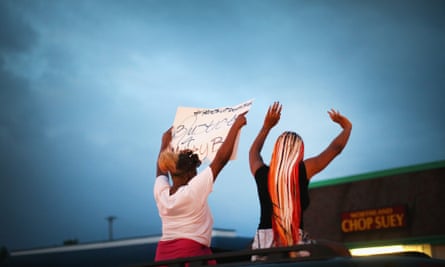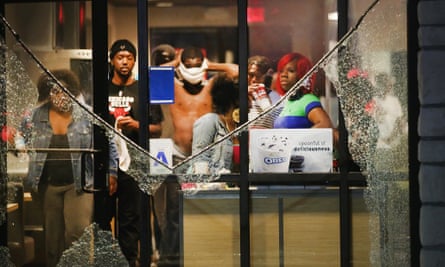The national guard in Missouri is to be deployed to the city of Ferguson after the most intense night of violence since the shooting of an unarmed 18-year-old, in which police used teargas against protesters hours before a midnight curfew came into effect.
Missouri’s governor, Jay Nixon, announced in the early hours of Monday that he had signed an executive order directing national guard troops to protect the northern suburb of St Louis from “deliberate, coordinated and intensifying violent attacks on lives and property in Ferguson.
“These violent acts are a disservice to the family of Michael Brown and his memory, and to the people of this community who yearn for justice to be served, and to feel safe in their own homes.”
The escalation in the crisis came after the eighth night of unrest since Brown was killed by a police officer, Darren Wilson, in disputed circumstances on 9 August. An autopsy released as the clashes raged concluded that Brown was shot six times, including twice in the head.
Bouts of gunfire rang out around Ferguson throughout Sunday night and early Monday morning. Three people were injured and a series of shops and restaurants were vandalised and looted. Heavily armed police repeatedly fired teargas and rubber bullets during running battles with the crowds. Several people were arrested for failing to disperse and journalists were detained and threatened by police with guns.

“Tonight, a Sunday that started with prayer and messages of unity, peace and justice, took a very different turn after dark,” Captain Ron Johnson of the Missouri highway patrol, which controls the policing of the protests, said at a 1am press conference on Monday.
“I had no alternative but to elevate the level of our response. We had to act to protect lives and property,” he added.
Police launched their first barrage of gas and smoke at about 9pm on Sunday after fearing an advance on their command post – in a mall parking lot just south of the centre of the clashes – by a largely peaceful protest march, according to Johnson. He said several molotov cocktails were thrown by those taking part in the march, which included children.
This was sharply disputed. “You need to pull these officers back,” Renita Lamkin, an episcopal pastor who has been trying to control the protests, told a police chief by phone, as teargas fell on the march. “There were no molotov cocktails,” she said.
An unrelated shooting about 20 minutes later outside a branch of McDonald’s prompted a stampede of people down West Florissant Avenue, the main road where conflict has flared since Brown was killed. Almost immediately, police deployed more gas and smoke grenades.
“That stuff doesn’t feel good,” said West, 23, who had tears streaming from his eyes. He said his throat was burning. “You really feel like you’re going to die.”
Young men in bandanas taunted police, picking up gas canisters and throwing them back. One man picked up an item that landed near his feet and immediately threw it through the main window of McDonald’s, as staff and customers screamed inside. Another picked up a nearby rock and threw it into another of the restaurant’s windows. Staff hid in a back room.
Another 20 minutes on, police turned on a high-pitch siren and fired repeated rounds of stun grenades into the crowd along with an even bigger gas bombardment. Yet dozens of protesters continued advancing back through the flashes and the fog towards the police. Many carried bricks and kerb stones they had broken to throw at officers. Others hurled bottles.
Police drove protesters with more gas northwards towards a burned out petrol station that was looted last Sunday. Some protesters smashed the windows of a hair salon and a storage facility as they passed. Then a burst of gunfire was heard over the road from the petrol station, sending people scrambling to the ground.

Protesters said they had no intention of backing down. “This is a revo-fucking-lution,” said DeAndre Smith, a 30-year-old barber. “Plain and simple, this is the revolution. The one everybody was waiting on. It happened like this. It’s the gain in culture by a people who want respect. African American people in this country.
“I been out here since day one. I was on the frontline. Mike Brown was the straw that broke the camel’s back. That’s when we said this is enough. That’s it.”
Following a standoff at the petrol station, police sent remaining demonstrators scrambling into side streets by speeding at them in armoured Swat trucks, firing yet more gas and smoke at people running away. The trucks continued driving up and down the main street doing this until it was cleared. As some reached a branch of Domino’s pizza, there were two more bursts of gunshots.
In Dellwood, just north of Ferguson, several people were injured when a crowd fled in their cars from a grocery store that was apparently being looted when police arrived. The injured were taken to hospital. There were still more than 40 minutes to go before the second five-hour long nightly curfew ordered by Nixon came into effect. But by midnight, most streets were empty. Later still, a standoff involving police took place on the street on which Brown was shot dead.
News of the results of the autopsy by Dr Michael Baden, a former chief medical examiner for New York, had begun circulating as protesters hid from police in side streets towards the end of the protest. “Shot six times,” people were heard saying.
The disclosure only looked likely to intensify the protests during their second week. “If they keep coming out here and doing this shit, then we’re gonna keep coming out here too,” said Smith. “They’re not gonna kill us off.”
Comments (…)
Sign in or create your Guardian account to join the discussion